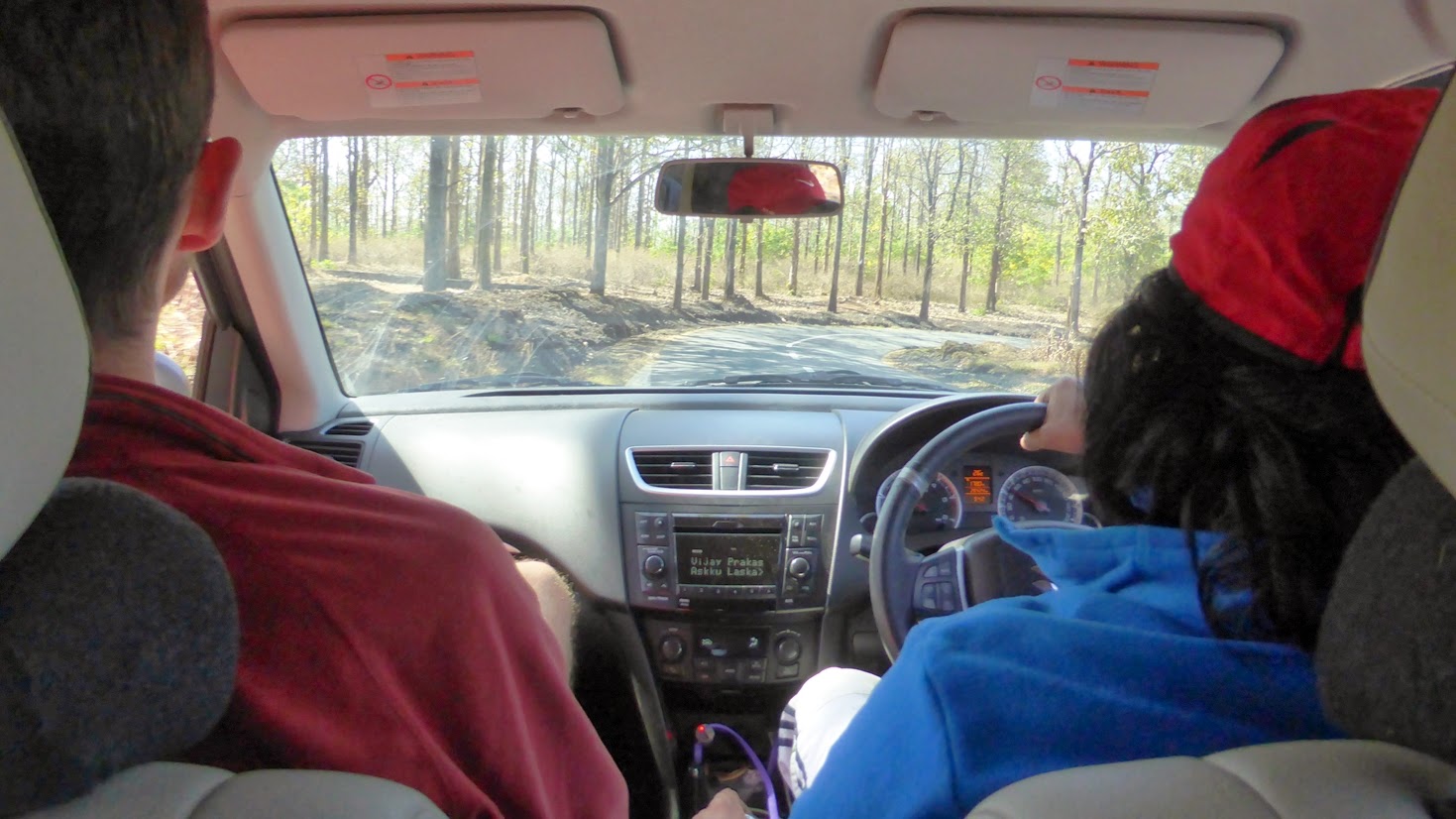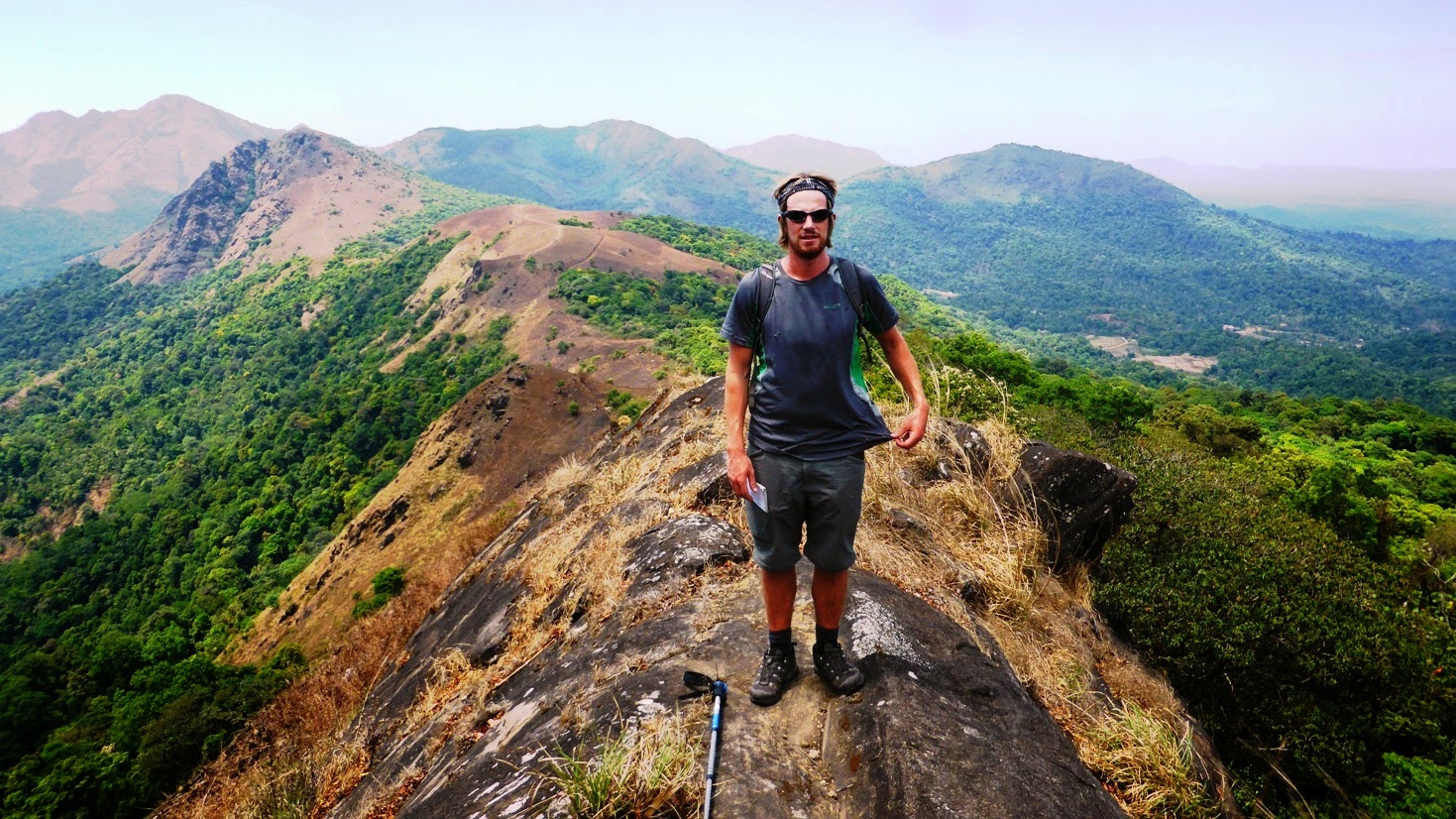In this blog: a roadtrip with friends, a breakdown, a safari, a walk through a tea plantation, and a free lunch (there is such a thing).
----------------------------------------------------------------------------------------
I love a good roadtrip, who doesn't? There's a real sense of freedom and excitement in driving with friends at whatever pace you like and seeing what happens on the way. So when Suresh, an Indian guy I'd met at Honey Valley, offered to give me a lift a few hundred miles to Bangalore adding that we could also stop at a national park on the way, I jumped at the chance. Nick, another guy I'd met there was also heading the same way so also hopped in, and so began a two day trip around part of Southern India.
 |
| Roadtrip! |
Having travelled almost exclusively on public transport for months now, the first thing that struck me was what a different perspective you have in a private car. The aircon dulls the heat, the soft suspension smooths out the roads, the seats bring you closer to the road and the music replaces the chattering locals. The result is that you feel a little disconnected from reality, as if all the rubbish, poverty, and general chaos might not be as bad as it seems. I asked Suresh how difficult it is to get your driving licence in India, and his reply was along the lines of 'pretty easy, especially for those people who pass some money under the desk'. This is pretty obvious on the roads.
We drove through rolling countryside, slowly leaving the mountainous area, but retaining the coffee bushes beside the road, something we'd become accustomed to over the past week or so. Passing a Maruti-Suzuki dealership - the make of car Suresh drives - we joked that at least we know where to go in case of a problem.
Half an hour later, the clutch went.
It was a very strange coincidence, especially as the car only had 30k miles on the clock, but we were fairly certain it was indeed the clutch. Suresh called the garage and stood waiting, whilst Nick and I strolled to a nearby village to find lunch. This cafe in the form of 'Friends Hotel' - a small grotty concrete restaurant with no running water nor English spoken, where everyone sat staring, a little shocked at the sight of these two foreigners in their local. After a bit of pointing at other people's food, we were brought a fish thali - a set lunch served on a stainless steel tray that has those indentations like school dinner trays, which consisted of a pile of rice and various small curries which you ate with just your fingers. It was a proper local experience, and fun with it.
 |
Broken down, and waiting
for the tow truck |
The local garage came out and very slowly towed us back to the garage, using a tiny Bedford Rascall type van that could barely make it up the hills. Arriving at the modern franchise garage they told us the clutch had definitely gone, but luckily had both the parts and men available, so got right onto it with an eager team of upto seven men working away. Or giving moral support at least. We spent the next four hours sat behind a big glass window watching them at work, whilst terribly produced Indian TV News rolled non-stop in the background, before finally we were back on the road, with Suresh' pocket £54 (5400 rupees) lighter for the pleaseure.
That night we stayed in another homestay within a coffee plantation, owned by a rather strange retired bank manager who cut the price for two rooms from a sensible price, to an amazingly cheap price without us actually asking. He then made us put our shoes in a cabinet outside which he hid with chairs, sat us down, stood us up to show the rooms, plied us with water despite it being late, locked the outside gates despite us leaving very early, and kept telling us how the TV worked despite our insistence that we were going straight to bed.
 |
| Spotted deer at Nagerhole NP |
At 5.45 the next morning we were up and on the road, heading to the nearby national park of Nagerhole, a large area apparently home to bison, elephant, deer, and even the odd tiger. We aimed to just drive through the park roads ourselves, but by chance found the official tour down the dirt tracks was about to leave so went along. The experience turned out to be pretty disappointing; going through the forest on a large bus driven by a guy who seemed like he was on a rally stage, with no tour guide, creaking suspension, squealing brakes, and grimy windows that you struggled to see through. All this meant most wildlife generally disappeared at first glance, if we saw it at all. That said, along the way we did manage to see some of the more common creatures of the wild - spotted deer, a sambar deer, a hawk eagle, jungle fowl and a few wild boar, which whilst not that exotic in Indian terms was better than nothing.
Feeling a bit deflated we left Nagerhole, and Suresh took us on a bit of a magical mystery tour of the area. We crossed the border from Karnataka state into Kerala state - known as one of the more highly literate and successful states in India, and it was noticeable from the moment we crossed the border. Most of the roads were very well surfaced and for once had actual white lines, barriers and road signs - something generally in short supply. The scenery was beautiful, the towns a little better kept than normal, the houses bigger and at times a little stylish for once. We passed butchers with beef carcasses hanging in the window - the only place apart from Goa where beef is eaten. Palm trees, banana trees, and flowering coffee bushes grew in fields along the road and the pleasant smell of the flowers wafted into the car. Most of the men walked around wearing a dhoti - a kind of skirt made by wrapping and folding a single sheet around their waist, and Christian churches were dotted around - a common sight in Kerala thanks to the colonial influence. Suresh pointed out a rubber tree plantation and we stopped to have a look, observing how they scrape the bark from a portion of the tree, and insert in a metal spout so the rubber slowly bleeds from the tree into a small pot. I'd seen photos before, but it was fascinating to see it in the flesh.
 |
| At 'God's own' tea plantation |
A couple of hours later, the scenery changed as we entered the Wynard region - one of India's main tea growing regions. I was blown away by the scenery straight away, with mile upon mile of rolling and sometimes lumpy hills covered in waist high, well-groomed tea bushes, patterned on the hills like coral. Suresh had book us in for lunch at a smart guesthouse he'd stayed at before - the boldly named 'God's Own Resort' - a play on Kerala's slogan of God's Own Country. Set a couple of miles down a dirt track on a hill in a 20 acre tea plantation, it was a truly beautiful place.
The owner was a really nice chap, and told us how they harvest tea all year round on a ten day rotation, taking it to the local tea processing factory once picked, then selling it afterwards at a tea auction to buyers such as Lipton. I spent an hour wandering around the plantation, chewing the odd leaf before discovering tea definitely tastes better dried than fresh. As well as rice, daal and pappadoms, we were given a particularly spicy beef curry for lunch - heaven when you've barely eaten beef for four months, and being slow cooked - very tasty. But the nicest bit of all was that the owner wouldn't accept any money for the food. None of us could work out exactly why, but it seemed the guy was both friends with Suresh's cousin and also wanted to encourage him to return and stay - very generous nonetheless.
 |
| Driving through Bandipur National Park |
With time disappearing it was time to head towards Bangalore. We headed briefly into Tamil Nadu state, then back into Karnataka where the roads were once again pretty awful; full of massive potholes, and stupidly placed, unmarked speed bumps in fast bits of road which caused everyone to suddenly brake hard upon seeing them. We drove through Bandipur National Park for an hour or so, passing briefly through an area that had a huge forest fire a few days before. We spotted very little wildlife save the odd deer and a chained up elephant, but was very pleasant nonetheless. The roads later got wider and faster, and Suresh sped up accordingly before I felt the need to rein him back a bit - my first and only time at 80mph on Indian roads was enough. We stopped briefly at Mysore palace as they have a light show there on a Sunday. Rather than improving the building, the rows of bulbs made the palace look like a carnival float, and having seen a few palaces on this trip now by choice or coincidence, I can't say the experience did much for me.
We finished the last leg of the tip on a four-laner aka dual carriageway, where the road discipline was terrible - something I hadn't noticed quite as much before in a bus. Drivers were overtaking, undertaking, driving on the dirt hard shoulder, cutting each other up, braking hard, not using indicators. The odd vehicle drove without lights, and everyone constantly beeping as ever. A small truck had lost a rear wheel, and was sat right in the middle of the road, whilst everyone swerved both sides around him. Despite all this we reached the bright lights of Bangalore in one piece late that night, feeling tired but satisfied with our eventful and fun roadtrip, and ready for Holi festival the next day.
 |
| Tea plantations |
 |
| Space for one more? |
 |
| Not a toilet break actually! |
 |
| Bandipur National Park |
 |
| Mysore palace by night |

















 We kept asking where the main events were but no-one seemed to know of any, so we decided to head a mile or two south to an area briefly mentioned in the newspaper. Finally, at long last, we found something. We came across a university where many students lined the road, covered head to toe in every shade of colour known to man, really embracing the spirit of the festival. We stood watching, and sure enough a few people approached us and started talking, before inevitably paint flew everywhere, then was rubbed over faces and into hair. Some of them took it a stage further and ripped off each other's shirts, but I managed to just about hold them back on this one, thankfully.
We kept asking where the main events were but no-one seemed to know of any, so we decided to head a mile or two south to an area briefly mentioned in the newspaper. Finally, at long last, we found something. We came across a university where many students lined the road, covered head to toe in every shade of colour known to man, really embracing the spirit of the festival. We stood watching, and sure enough a few people approached us and started talking, before inevitably paint flew everywhere, then was rubbed over faces and into hair. Some of them took it a stage further and ripped off each other's shirts, but I managed to just about hold them back on this one, thankfully.




























